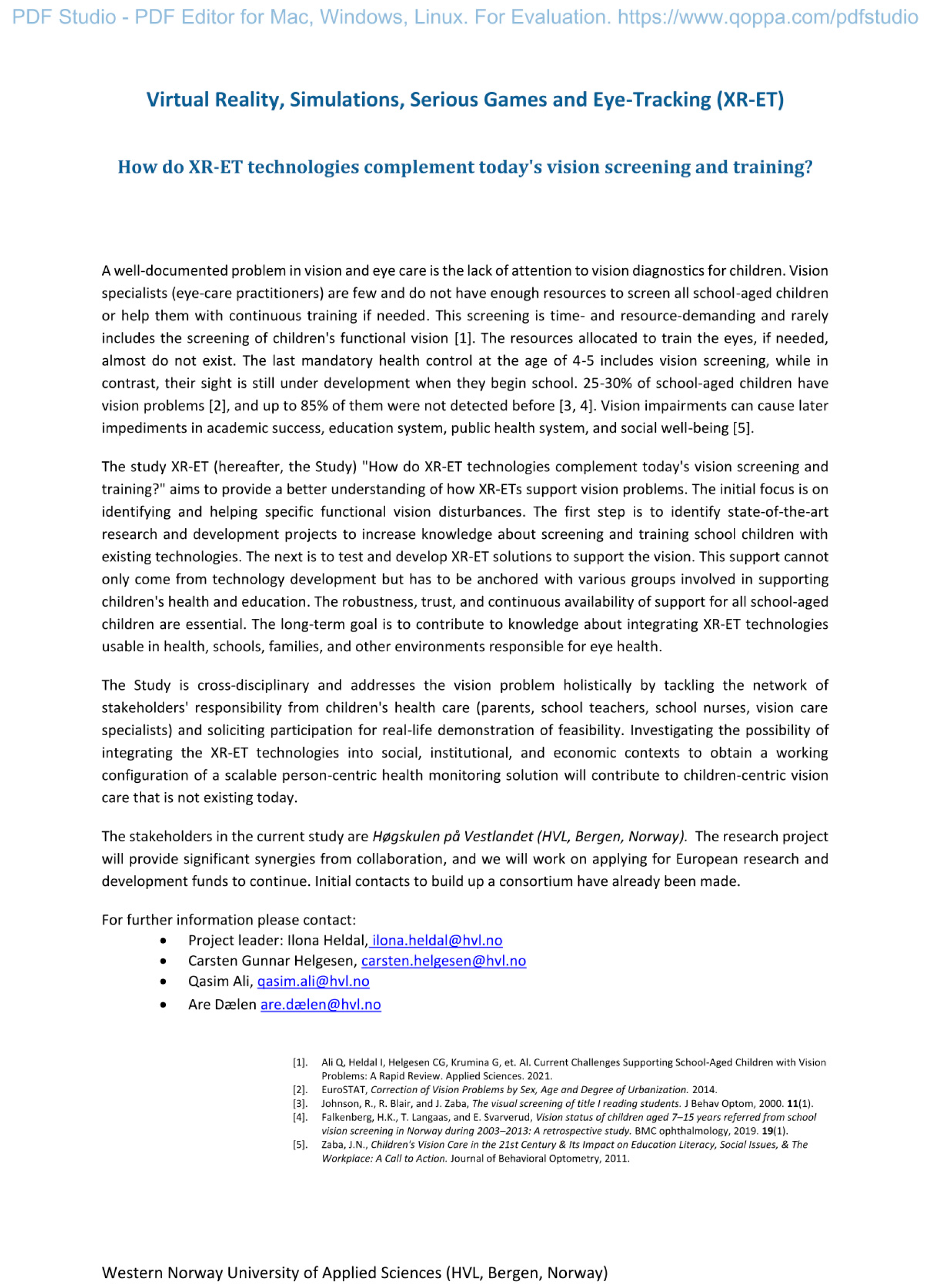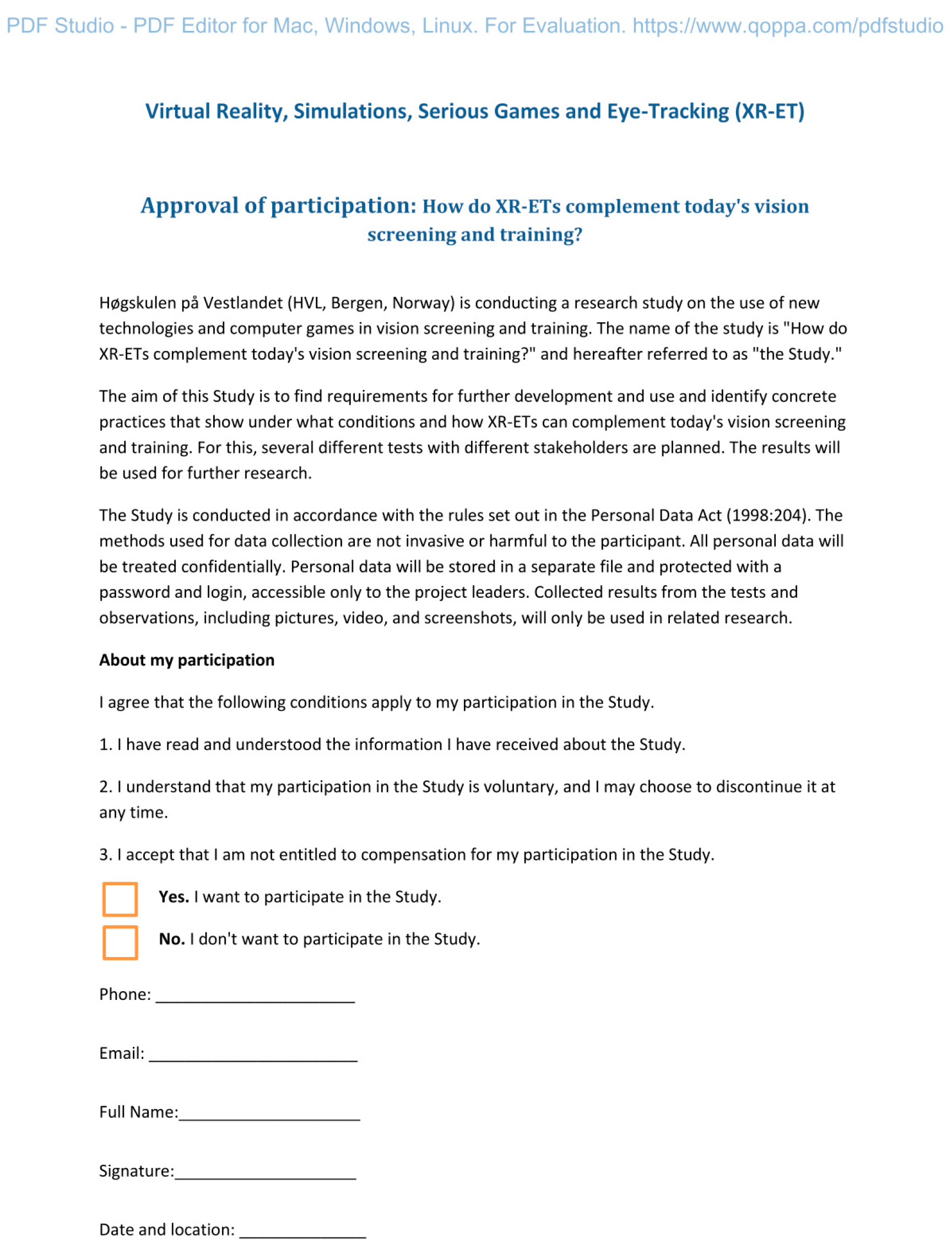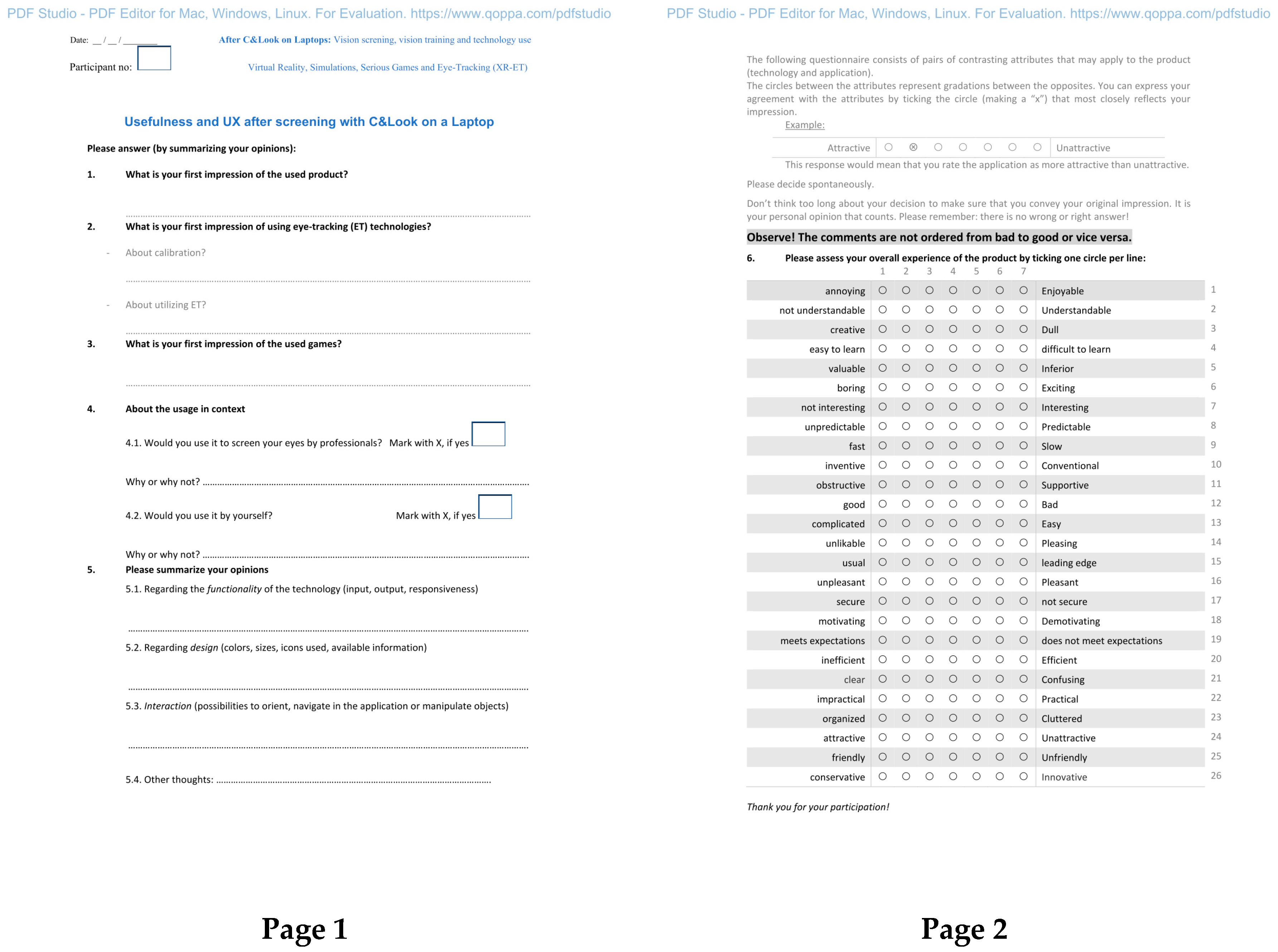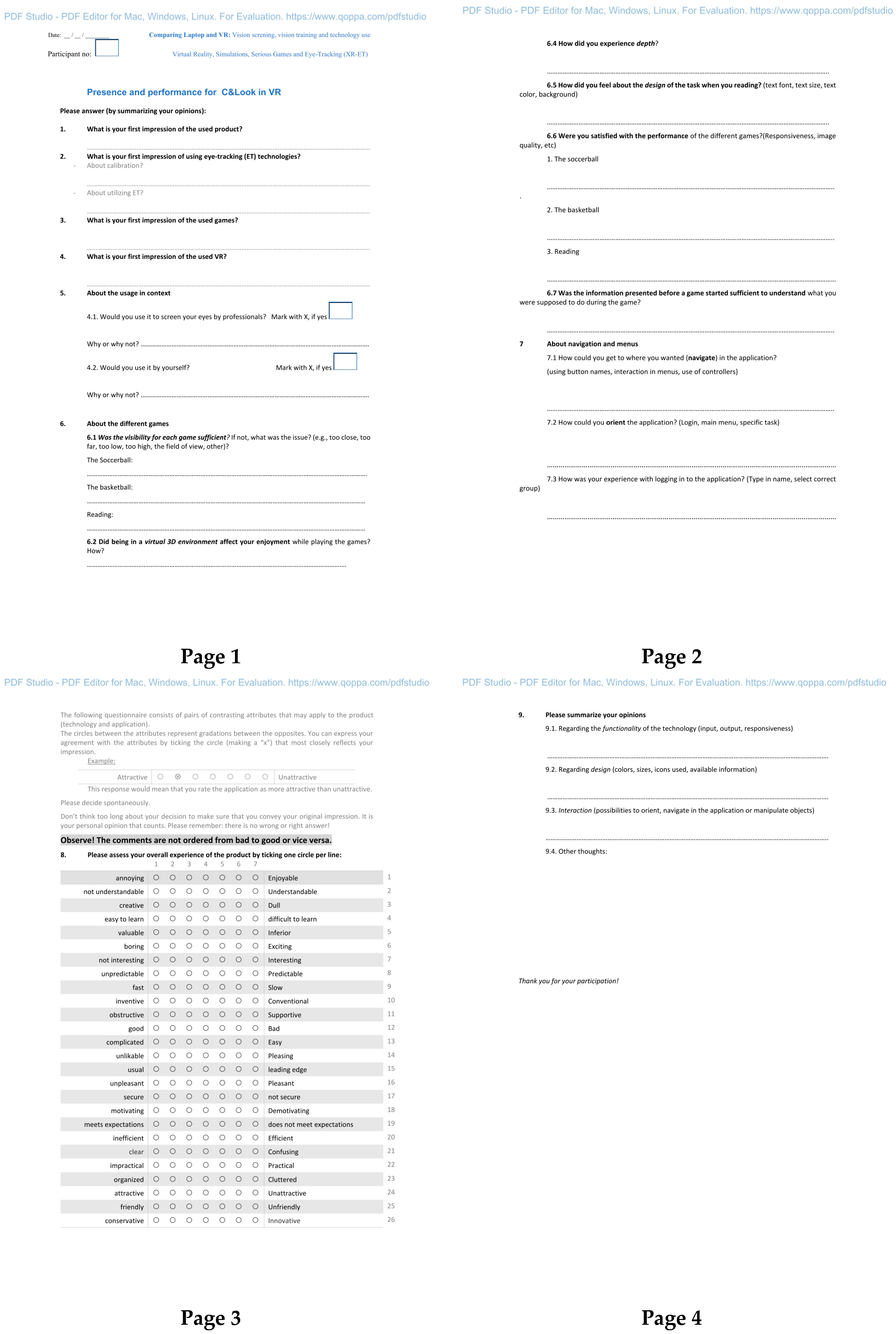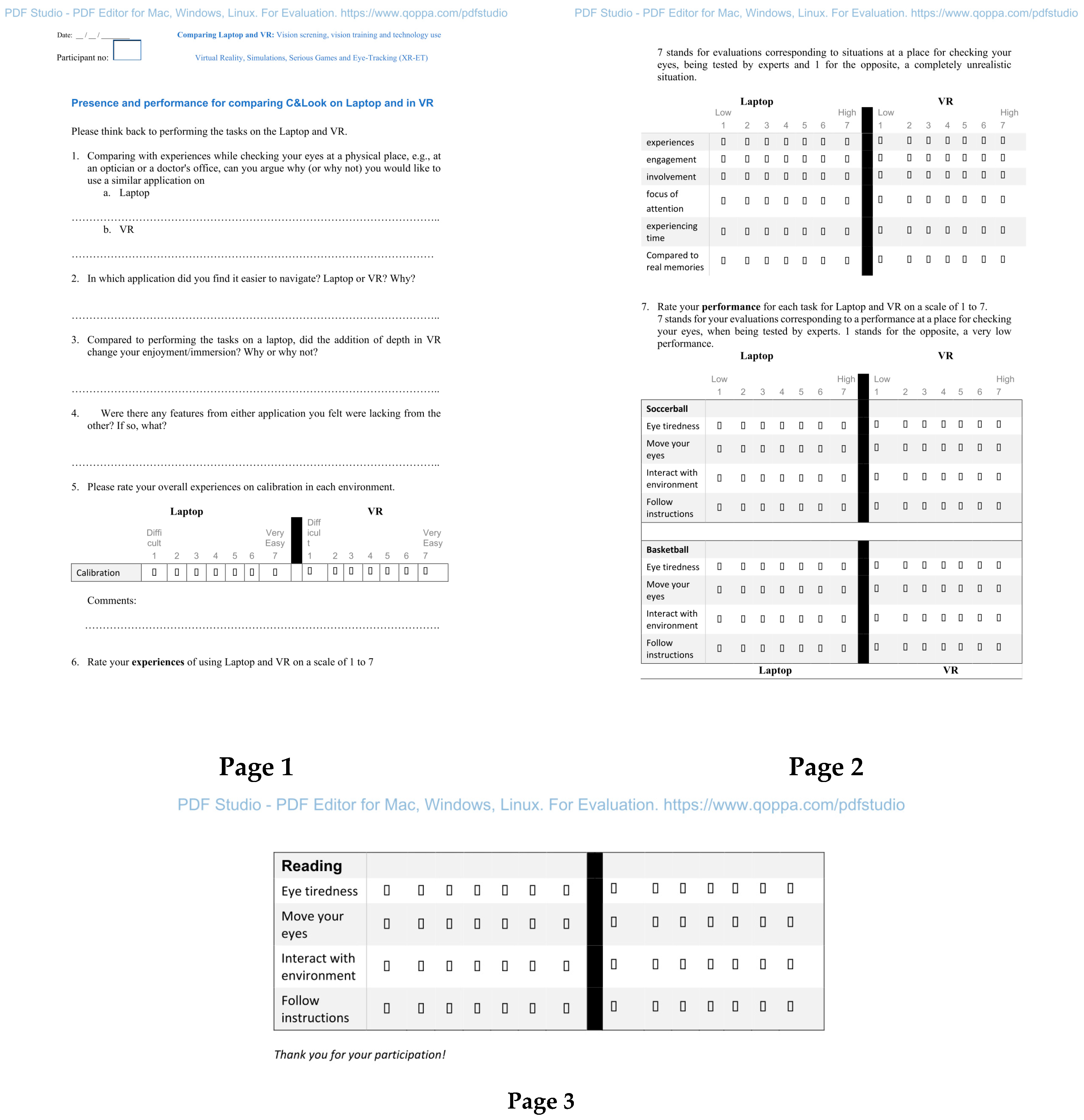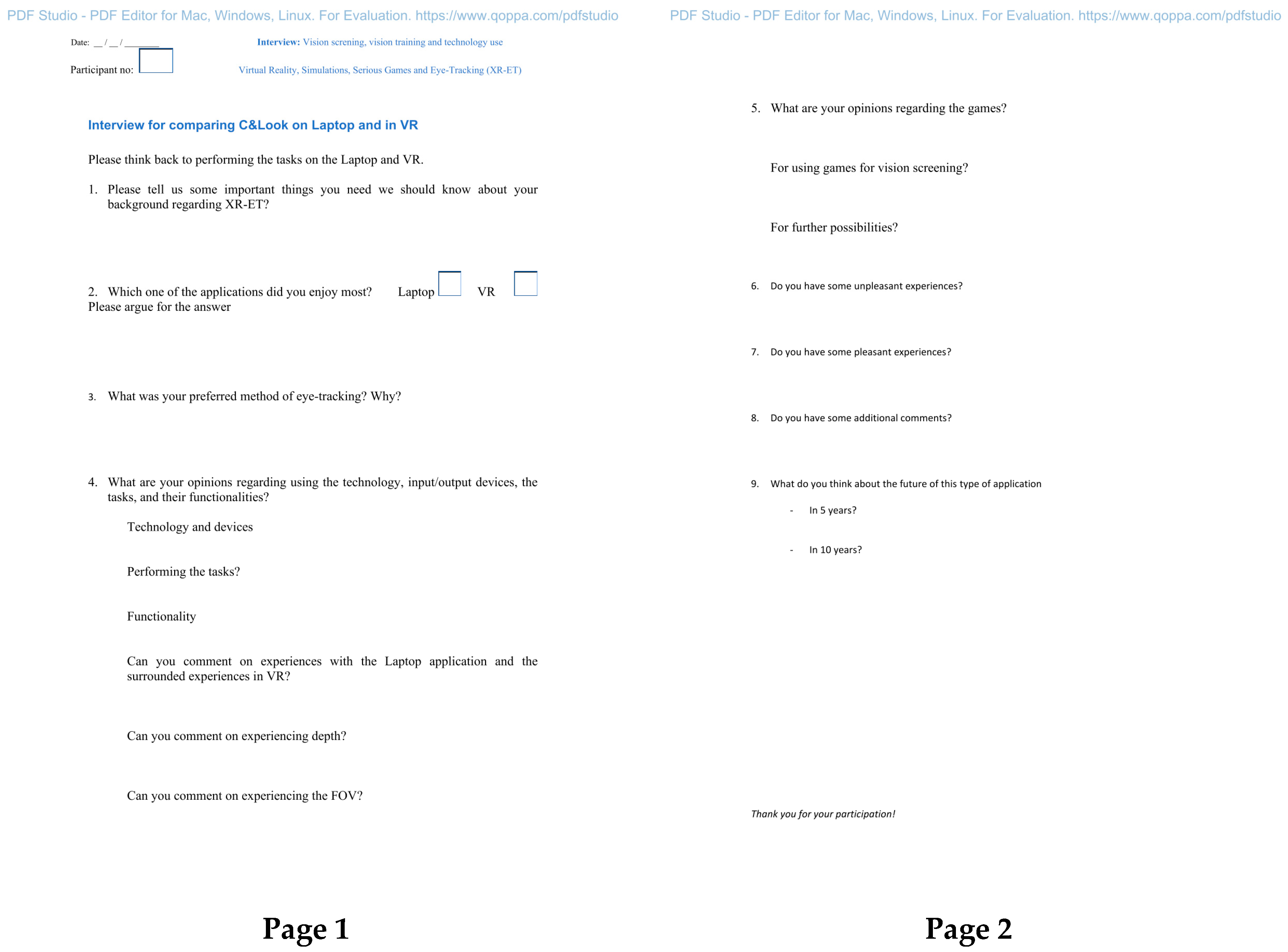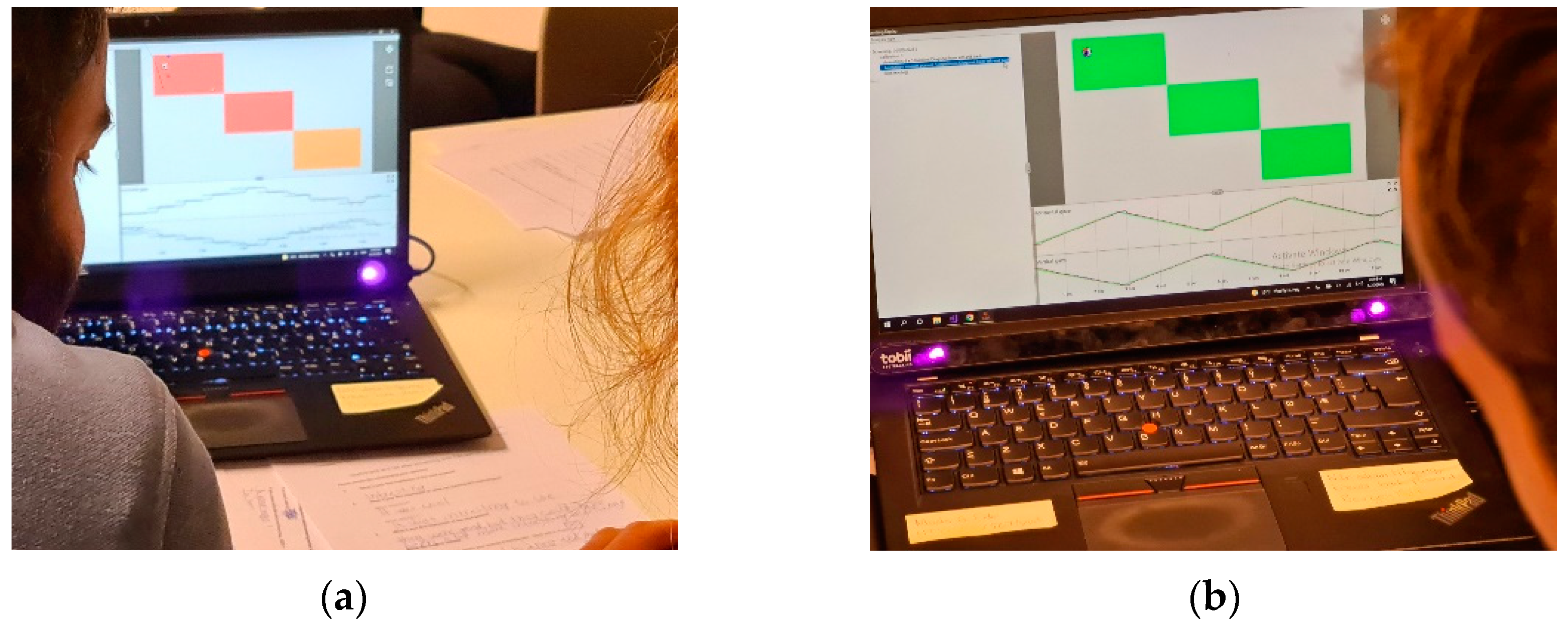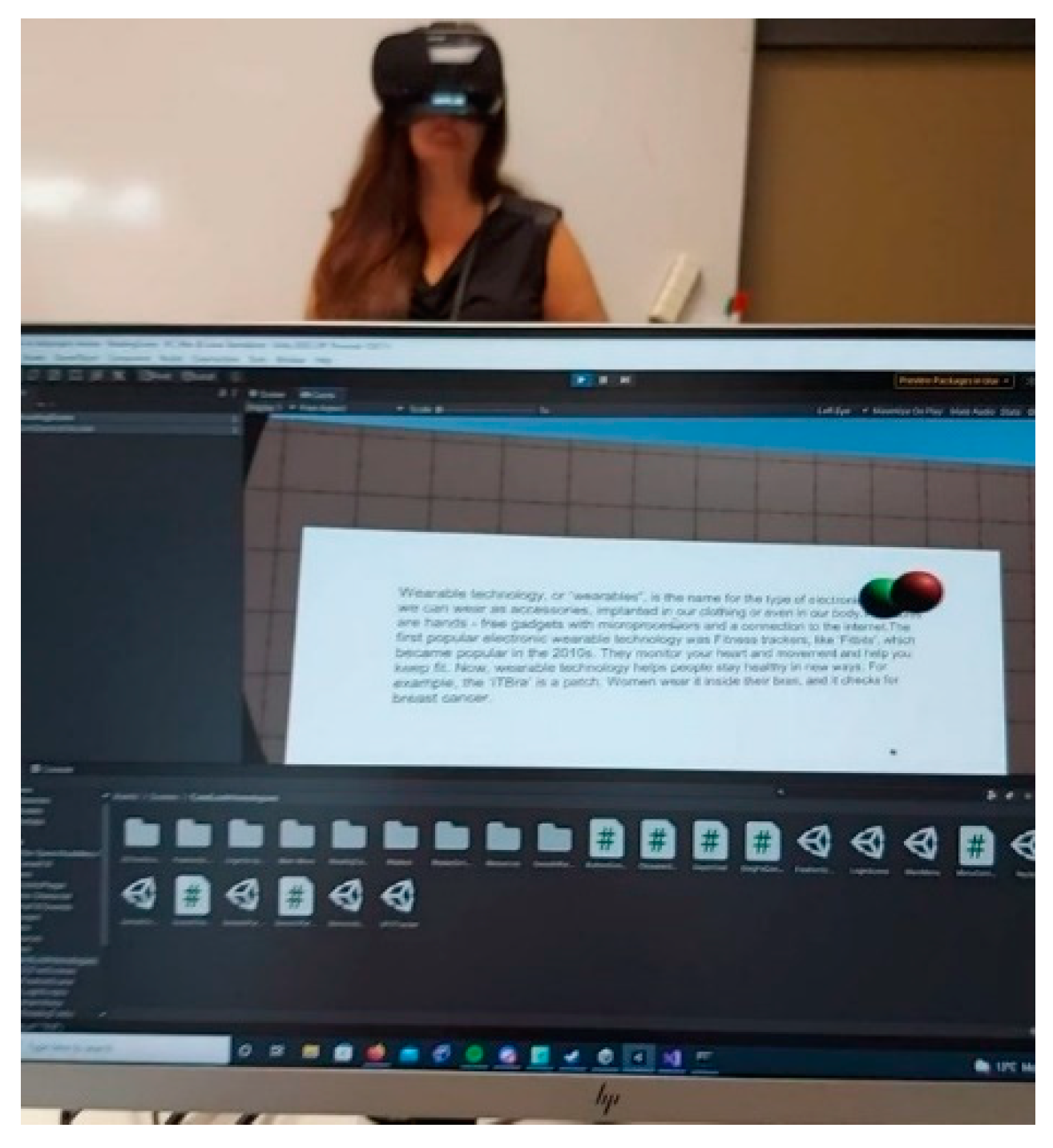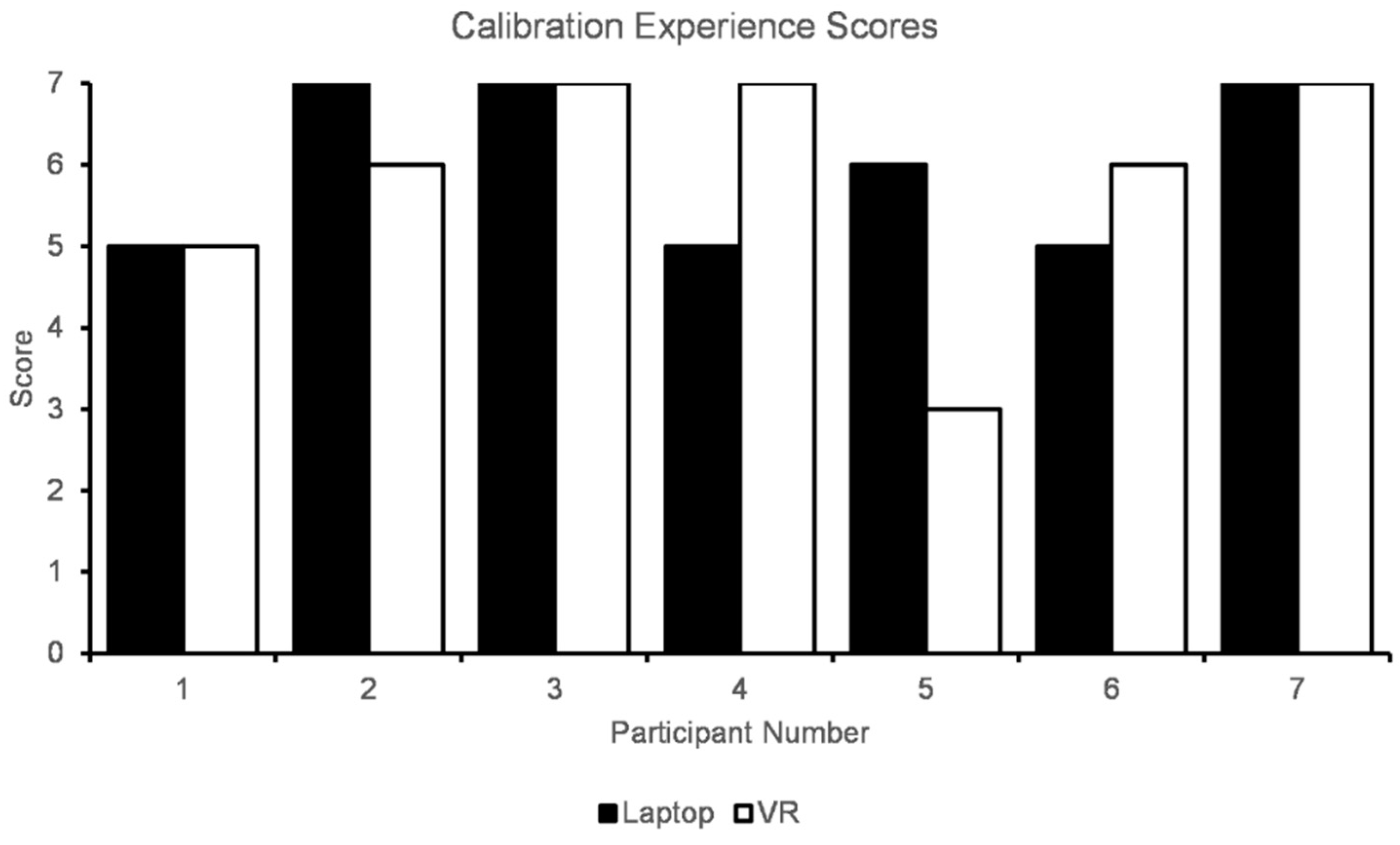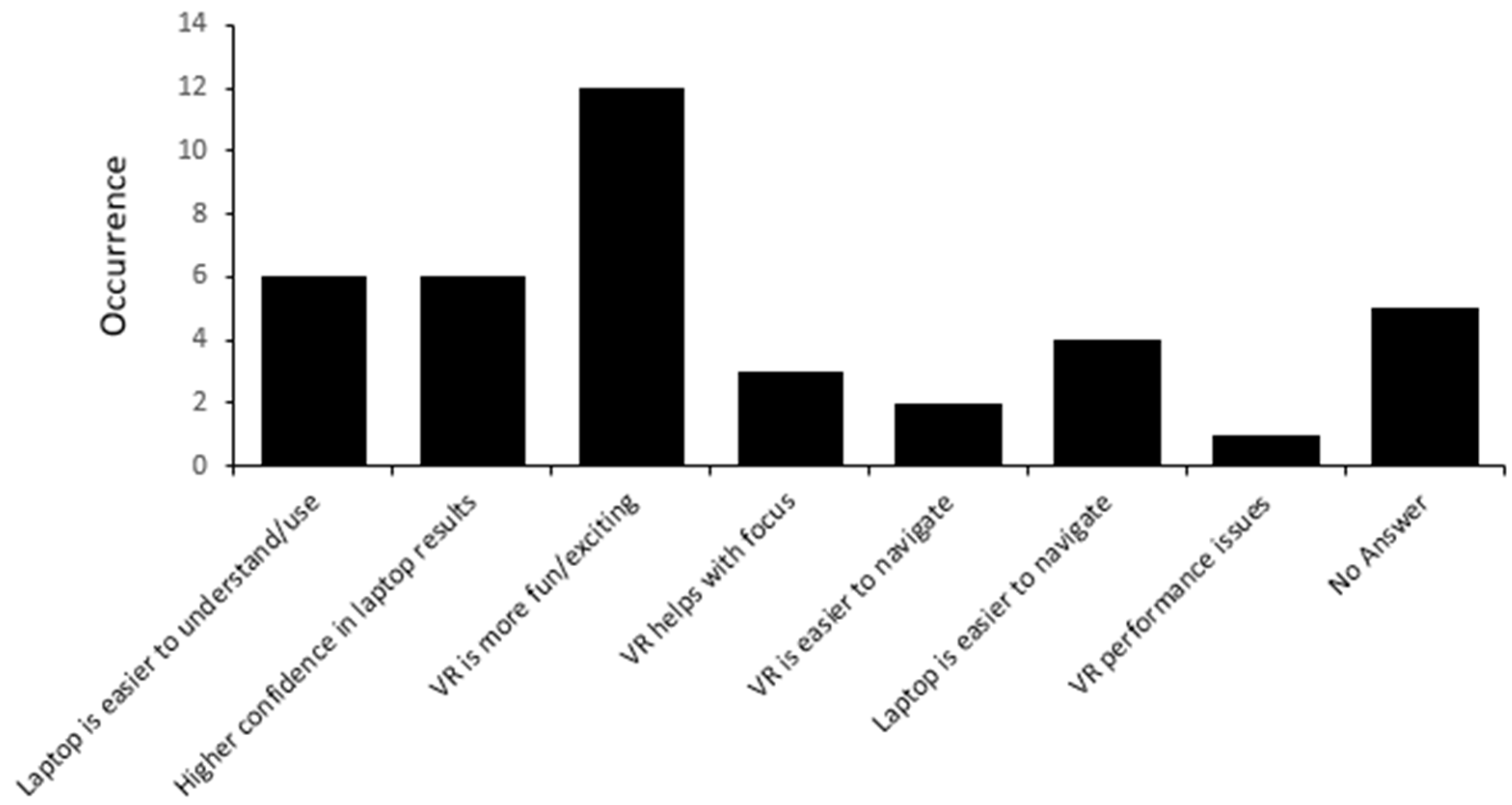1. Introduction
Several people can have eye disorders and diseases. Many common problems can be identified by visiting clinical experts, e.g., ophthalmologists, orthoptists, or some clinical specialists in vision, and corrected with eyeglasses or surgery. However, vision problems can occur even if the eyes seem normal, and the results from the most usual vision tests (e.g., visual acuity assessment, refraction for eyeglass prescription, or examination of the anterior and posterior segments of the eye) do not show vision disorders [
1,
2]. Some people may have problems processing visual information, addressed in this paper as Functional Vision Problems (FVPs). These, also known as functional visual disorders or functional vision impairment, refer to disturbances that cannot be explained by structural or physiological abnormalities in the eyes. These conditions are characterized by a mismatch between the actual eye health and the visual symptoms experienced by the individual. These are sight disturbances hindering one from, e.g., correctly estimating distances, reading, or experiencing problems with their balance. FVPs are common, especially in stroke patients [
3,
4] or in adults suffering from brain injury [
5]. Not diagnosing FVPs can have negative consequences, especially for children who cannot necessarily realize and report their problems and are not tested by usual vision testing with the ages of 5-7 [
6].
Oculomotor dysfunction (OMD) is an FVP related to problematic coordination between the left and right eye. Approximately 17-30% of children with vision problems have problems related to FVPs such as OMD [
7]. These problems can lead to more severe vision disorders if not treated correctly, however, many children do not know that they have OMD, and the impact is it has on their vision [
7]. FVPs are a societal problem that cannot be solved with current resources due to the limited number and capacity of vision professionals [
6,
8].
Utilizing eye-tracking (ET) technologies shows great promise in the identification of OMD [
9]. These ETs are integrated or attached to laptop systems and, based on following a person’s basic eye movements during a time, helping professionals approximate if the person has or does not have OMD related vision problems. Due to the limited screen size and the inability to measure depth accurately, essential issues for a complete vision screening, these solutions have inherited limitations. Measuring basic eye movements helps professionals understand how a person can focus on objects (measuring fixations), follow objects with their eyes (measuring smooth pursuits), or jump with their eyes from one object to another. Since the two eye movements can be measured separately, how the eyes are coordinated can also be measured, making this solution highly effective for examining FVPs related to OMD. There are already validated solutions on the market offering ET and laptop-based measures to professionals engaged in screening FVPs [
10]. Supporting screening via technology is essential since vision screening should be based on objective measures and take less time. A complete vision screening, including screening for FVPs, takes more than one hour [
11], and there are not many professionals who are educated to perform this.
Since VR equipment allows experiencing a larger Field of View (FOV) and depth, the hypothesis behind this work is that VR can add to future vision screening batteries. Until now, we are not aware of research or practice utilizing VR equipment for vision screening. This may be evident due to the main limitations of VR, e.g., handling “binocular disparity is a critical stimulus to vergence, which is a critical depth cue” making those eyes “are always focused on a single depth,” which implicate loss of focusing and in accommodation in a current review considering ET in VR. However, this review is positive for utilizing larger FOV, by a foveating view or for specific vision testing, e.g., for contrast sensitivity [
12]. Another review, also considering AR technologies argues for many limitations such as including unsatisfactory accuracy, weak validation, and hardware limitations, but promising user experiences [
13]. However, not many studies examine how these experiences are, more in detail.
VR is also a technology that allows for vision training [
7], which can help, e.g., for training stroke patients [
14] or children with OMD [
15]. Since many FVPs, and in particular OMDs, can be helped by training [
16], to see the effects of the training this should incorporate screening possibilities. According to our knowledge today, there is no VR application for screening OMD and no VR eye training application incorporating the possibilities of screening.
In the background of this paper is an experimental study implementing a laptop-based application to screen FVPs and developing an immersive virtual reality (VR) based prototype and evaluating its usability [
17]. This paper takes a step forward and focuses on the importance of VR experiences for OMD screening and the current challenges through experiencing presence. The overall goal is to highlight user opinions on utilizing VR for screening and training of vision problems. This focuses on their experience with ET calibration techniques, feeling of presence, comparison between a laptop and VR-based solution, and feedback from open-ended questions and interviews which provides additional justification to questionnaire answers.
While the value of having OMD, and later FVP screening in VR is clear, the way to achieve it depends on technology, context, application, and users [
18].
The structure of the paper is the following. We present related literature from VR-based, and laptop-based screening in Chapter 2. Chapter 3 presents a screening tool (C&Look) showed usable on laptop and imported into VR. Study design including data collection methods, test approach, and a brief introduction to analysis methods are described in Chapter 4. Chapter 5 presents analysis of answers to questionnaires and interviews. The context for these results are discussed in chapter 6, along with presentation of current limitations and future work for the project. Chapter 7 provides a conclusion to this paper, presenting an overview of the findings from this study.
2. Literature Background
VR provides a surrounding experience by simulating a real-world environment with help of technologies and users can be surrounded by 3D projection in a room. For example, in a Head-Mounted Display (HMD), when the user is wearing special glasses allowing them to see 3D projections around themselves [
19]. Immersion, as defined in the literature, refers to the characteristics of technology to allow experiencing this 3D environment in space, not only on a 2D surface. Accordingly a HMD is an immersive technology and a laptop is not. Presence refers to experiencing being physically present in a computer-generated application and the interaction in it can be as believable as the interaction in the non-mediated conditions [
20].
VR has gained significant attention from researchers due to allowing a larger field of view than a laptop, enabling more natural interaction, for example, with the hand, head, or body tracker with a computer-generated environment and built-in eye tracker for gaze recording. For enabling high presence or distracting the users from a painful or boring situations VR is appreciated in various fields, from experiencing new bridges or buildings, training to fight fire or be prepared for surgery, pain management, anatomical education, or the treatment of psychiatric disorders. In recent years, VR has integrated ET technologies and emerged in the field of vision science, integrating built-in eye trackers into HMDs [
12]. Therefore, today VR has the potential to be an effective tool in complementing the treatment of a variety of vision disorders, e.g., treating amblyopia [
21], convergence insufficiency [
22] or augmented reality for treating strabismus [
23].
Laptop technologies, in general, and for a longer time showed promises to complement the treatment of amblyopia, strabismus, binocular vision disorders, and visual field deficits [
24,
25]. However, developing associated algorithms and analyze gaze measurements from ET data for fixations and saccades are available, more exact measurements are needed for better confidence in the results both for laptops and VR [
9]. Experiencing presence in the environments is crucial, as an example, for feeling agency [
26], and therefore, our hypothesis is that evaluating user experiences, presence, and the role of serious games can help forward research about these technologies.
VR systems do not aim to reproduce an experience as realistic as in films or fiction, the experience and presence in the environment, and knowing how to react to the events, are important. Working with the technology, where the technology itself is hidden and goes away for the good of the application is significant for increased user engagement, motivation, and enjoyment [
19]. Since experiencing presence can be considered an added value for VR technologies, many testing aims to collect measurements about presence. These tests can be done by addressing user opinions, e.g., by observations, questionnaires, or interviews, but also by trying to make sense of users action in the environments, e.g. by sensing technologies, such as ETs or EEGs and find more objective measures for presence.
Given the high prevalence of vision problems in the general population, functional vision screening is important for early detection and timely treatment, which can significantly improve visual outcomes and quality of life [
6,
27,
28]. The literature also showed that using serious games increases motivation for learning or performing tedious, repeated, or painful activities e.g., [
29,
30].
Despite the growing body of research on the therapeutic applications of VR in vision rehabilitation, to our knowledge, there has been no exploration of how subjects are experiencing presence of VR-based vision screening.
3. The C&Look application
3.1. Developing a laptop-based application
The C&Look program developed at HVL for FVS uses affordable eye-tracking technology to support existing detection methods for OMDs [
3]. It utilize eye-tracker technologies that has to be started on a laptop, calibrated and used with a structural, systematically developed application, designed together with vision experts [
31]. The use of eye trackers connected to a computer has some limitations such as screen size, for e.g. peripheral vision, and head positioning, for e.g., not allowing larger head movements during the screening. However, it provides new possibilities as the data gathered over time allows for analysis of eye movements, and such difficulties only were possible to examine by ocular examination of vision experts. Further, it has been illustrated the affordability of eye-tracking technologies can assist vision experts in detecting children's oculomotor dysfunction (OMD) and how them can incorporate this technology into their screening procedures [
11].
The C&Look program runs on a laptop with ET technologies. Vision experts can choose and adjust a number of tasks and define a task battery for screening, depending on the possible problem of the users and their characteristics (most often age, but also eventual disability, reading competence). After calibration, the screening is performed. After the screening, the performance of each user (how they perform the task and how their eyes, separately the left and right are synchronized, e.g., by fixation, saccade, smooth pursuit) can be analyzed separately. The screening battery includes graphical tasks with measured fixations, saccades, smooth pursuit, and different measurements from reading tasks [
3]. Fixation, smooth pursuits, and saccades are major eye movements connected to how people can focus and follow objects. Examining eye movements during reading is considered a good indicator of identifying OMD, a coordination problem between the left and right eyes [
11]. Fixation tasks consist of an object moving stepwise across the screen in a predetermined pattern; smooth pursuit tasks follow objects, while saccades are measured for an object jumping from one position to another. Reading tasks display any text to the user, depending on her age and interests, adjusted by the person who sets up the screening. The program records the eye movements while the text is being read. The application also boasts its calibration method and a comprehensive results screen with replays and graphs visualize both eye positions during testing.
The analysis toolkit superimposes the user's eye movements allowing the examination of collected measures, alignments, and together with information about the performance (
Figure 1). The analysis can be done for one task or just specific parts which can be associated with special measurements. Current issues with the application include strict user positioning for gaze data collection and the inability to measure aspects of vision related to depth.
3.2. Development of a VR-based application
When transforming C&Look to VR, the first step was to convert the same tasks (fixation, smooth pursuit, reading) into a 3D environment. Both the fixation and smooth pursuit tasks follow the same principles when it comes to stimuli movement, although these objects are now 3D and move in a 3D space. The reading task in VR is almost identical, with text being displayed on a plan-screen in the virtual environment. The difference between this task from a laptop and VR comes from the canvas positioning and being able to dynamically adjust the distance between the player and the text. Calibration in VR utilizes the Varjo SDKs built-in calibration method, while results include a live replay with visualization of gaze points. The VR version currently lacks graph visualization of eye positions during testing. Few implementation methods could be reused when developing VR, as the added third dimension changes object movement, gaze point visualization, and necessary calibration techniques. This led to this new application being built from the ground up, except for utilizing the same database.
To transfer C&Look into an immersive VR application using eye behavioral data, and to investigate how to complement manual vision screening and C&Look, the prospects and limitations of using a head-mounted display (HMD) are analyzed. The HMD used is a Varjo VR2-Pro, as it is one of the leading VR headsets with embedded ET together with hand controls (see
Figure 2).
The sampling rate of integrated ET in the Varjo HMD is 100Hz. Varjo also allows investigating hand and eye coordination. This functionality is useful for recognizing FVPs, since problems with how the eye functions are highly correlated with other functions, e.g., balance or hearing [
9].
While the 2-dimensional version of C&Look provides high-quality data when testing for oculomotor problems (OMD) it lacks the possibility of capturing important tasks performed during a special performance that is included in manual vision screenings. The laptop system used for testing the original version of C&Look had a screen size of 14 inches and utilized a Tobii 4C mobile eye-tracker with a sampling rate of 90Hz. The performance of the laptop-based C&Look application was investigated comparatively in a set including two applications for the same tests, one based on higher sampling rates and one with lower [
32]. The applications were approximated to be similar and with testing performed by the involved vision teacher (see
Figure 2).
4. Study Design
After implementing C&Look in VR the program was tested several times by random students. Each participant tested both C&Look on a laptop and on VR and quantitative data collected from the participants. During this time, a test battery was developed to collect data anonymously concerning Norwegian ethical requirements. This test battery (presented in
Appendix A) includes:
Information about the study (written and oral information)
Consent for participation
Background information about the participant t's familiarity with vision control and their familiarity with new technologies (ET, VR, and serious games)
Questionnaire about experiencing the laptop version of C&Look
Questionnaire about experiencing the VR version of C&Look
-
Comparison questionnaire for the laptop- and the VR-application.
- a.
Open-ended questions related to the feeling of presence and comparative elements of both applications.
- b.
ET calibration experience questionnaire.
- c.
Presence questionnaire for the laptop- and the VR-application.
9 interview questions with the possibility to discuss after each about comparatively evaluating their presence and experiencing the technologies and serious games.
This experimental study was tested by 7 subjects, one vision expert (a teacher in special education with competence in vision), and six other voluntary subjects in June 2022. Testing one subject lasted between 60-90 minutes. The first subject was one vision expert critically examining the test battery on the laptop and VR applications; the last one was adjusted after her comments. All participants, except one, had some vision difficulties, but all participants experienced vision testing at a vision specialist earlier.
The test was performed in the following way: Introduction (using questionnaires 1-3), performing a randomly assigned vision screening (laptop or VR), and after each set, the subjects filled in a questionnaire (questionnaire 4 or 5). After the first application's vision screening and data collection was completed, the process was repeated for the remaining untested application. The evaluation of the user experience (UX) of the laptop and VR application was inspired by an overall UX questionnaire [
33]. Each participant filled out the comparison questionnaire (6) after having tested and evaluated each application separately. This questionnaire begins with open-ended questions related to the feeling of presence and comparative elements of both applications (6a). During the comparison questionnaire, participants were asked to rate their experience with calibration in each environment (6b). The activities during application testing involved 2 different calibrations on the laptop, one from Tobii and one developed in this environment for more precise calibration. For the VR calibration, Varjo’s legacy calibration method was used. These calibration methods were ranked on a scale from 1 to 7, where 1 indicates difficulties with calibration, and 7 relates to an easy calibration experience.- For the comparison questionnaire, a modified overall presence questionnaire (6c) was constructed inspired by earlier work from Slater [
34,
35].
The testing session ended with semi-structured interviews about the comparative experiences, aligning the experiences to earlier familiarity with vision screening and using VR.
User experience and usability evaluation have been presented in an earlier study, showing similar high quality results for both applications except for a few performance issues in VR [
17]. The study also highlights many limitations of the used HMD and the need for interdisciplinary assistance for development with the vision science domain experts when developing a vision screening suit for VR. For this study this experience was based on vision expertise from an earlier study developing C&Look for laptops [
3], as well as testing of an early prototype of the VR application on a vision expert to influence further development.
To analyze the data collected through questionnaires and interviews, different analysis methods were used. Calibration experience results have been plotted into a graph for better visualization (Section 4.1). Open-ended questions regarding comparative elements and presence were analyzed using code analysis (Section 4.2). Presence questionnaire data was averaged separately for both applications, providing a mean sense of presence score for all tasks performed in different environments (Section 4.3). Interview answers have been compared to other results for user experience and presence, relating answers to each participant and their previous experience with vision screening/testing (Section 4.4).
5. Results
The results presented in this section include different techniques for analyzing user feedback. This includes calibration experience results, code analysis of answers to open-ended questions, task performance similarity results, and analysis of feedback received during interviews.
5.1. Calibration Experience Results
When collecting ET data from users, calibration of ET technologies is a mandatory step to ensure high-quality data collection. The laptop and VR screening applications use different calibration methods, with the laptop version using a custom-made calibration screen proposed by Eide and Watanabe [
3], and VR utilizing Varjo's built-in legacy calibration mode. When asked to compare these methods in step 6a of the testing battery, ranking each calibration method on a scale from 1 to 7, feedback from test participants varied greatly. Scores for each calibration method per participant are shown in
Figure 3. The average score for calibration on a laptop is 6, while the VR method scores an average of 5.85.
Both calibration methods produced similar averages, with the VR version falling slightly behind the laptop version. However, this difference was influenced mainly by Participant 5, who had difficulties calibrating in VR due to wearing glasses. On the other hand, participant 7 also wore glasses but had no issues calibrating in either environment, giving both calibration methods a score of 7 when asked to rate their experience.
5.2. Open-ended Questionnaire Results
Open-ended questionnaires were administered to participants in step 6a of the testing battery to compare different aspects of the two applications. The questionnaires were designed to get qualitative feedback from participants about their experiences with each application. The following are the questions:
-
Q: Comparing with experiences while checking your eyes at a physical place, e.g., at an optician or a doctor's office, can you argue why (or why not) you would like to use a similar application on a laptop?
Q: In which application did you find it easier to navigate? Laptop or VR? Why?
Q: Compared to performing the tasks on a laptop, did the addition of depth in VR change your enjoyment/immersion? Why or why not?
Q: Were there any features from either application you felt were lacking from the other? If so, what?
To analyze participants' responses to the open-ended questions in step 6a, each answer was assigned a "Code" based on its intention. Each response was given only one code, ensuring responses have the same weight. The following codes were used:
"Laptop is easier to understand/use": indicated that participants found the laptop application easier to use, especially those with limited technological background or prior knowledge of the system.
"Higher confidence in laptop results": indicated an interest in better data representation and collection for the VR environment, leading to higher confidence in the laptop application's results.
"VR is more fun/exciting": highlighted the additional immersive elements that VR brings, with an emphasis on enjoyment.
"VR helps with focus": included mentions of participants finding task performance easier or more motivating with fewer outside disturbances in VR.
"VR is easier to navigate": and "Laptop is easier to navigate" described preferences for different user interfaces and navigation options.
"VR performance issues": included responses that mentioned optimization issues in the VR application.
"No Answer" contained answers that were non-existent or completely unrelated.
Figure 4 shows the number of occurrences for each code based on participant answers to each question. The numerical values in the graph represent the number of times an open-ended question answer was given a specific code. As an example, the “VR helps with focus” code was given to 3 responses.
Although most participants (n=6) preferred the reliability and confidence in results from the laptop application, the highest code occurrence was "VR is more fun/exciting" (n=12). Participants reported being more engaged when using the immersive elements of VR, which motivated them to perform tasks correctly. Additionally, some participants mentioned having a higher level of focus when performing tasks in VR, as there were fewer outside disturbances.
5.3. Task Performance Similarity
Each participant performed three different tasks in both applications. In step 6b of the testing battery each participant was asked to rank different aspects of tasks on a scale from 1-7. This ranking focuses on the similarity of performing tasks to what it feels like to perform a similar activity at a specialist’s office, where 7 stands for evaluations corresponding to situations at a place for checking your eyes, and 1 for the opposite, a completely unrealistic situation.
Table 1 shows the average similarity scores given for each question on the laptop application, while
Table 2 shows the average scores for the VR application.
Every question, except for "Move your eyes" on the fixation task, received a higher average user score in the VR application than in the laptop application. This indicates an increased sense of presence in the VR environment. While some of these aspects are not necessarily positive, such as “Eye Tiredness”, their higher averages indicate that execution of screening tasks in VR produces a feeling like that of performing homogenous activities at a professional place for testing your eyesight.
5.4. Participant opinions on using serious games for vision screening
This subsection includes the comments from the participants to the question, "What are your opinions regarding the games?", associated with direct comments about the game experience from the interview.
Table 3 shows each participant’s previous experience with vision screening/testing, as well as opinions about using the developed games in VR and on laptops.
Although their preference for either laptop or VR changes, participant 1, 2, 4, and 5 expresses increased enjoyment when testing with games and an interest in performing future vision screenings via games. Participants 1, 3, and 7 mentioned appreciating being able to better understand their own eye movements when using the applications. The test subjects mention multiple shortcomings of the VR application, such as Participant 4 wanting more use of depth, participant 6 finding VR more difficult to operate and the reading task boring, and Participant 7 mentioning performance issues during the smooth pursuit task.
6. Discussion, Limitations, and Future Work
The current laptop FVP screening solution is limited by available screen size and the inability to utilize depth. Contemporary research shows that measuring depth perception is possible using HMDs [
36,
37]. A stereo acuity task attempting to measure depth perception in VR was developed as part of this study, however, implementation proved difficult, as scaling and generation of 3D models to represent extremely shallow angles (200-400 seconds of arc) introduces high computational complexity. This resulted in difficulties in measuring and lagging, observable for users. It was also discovered that small errors from the eye-tracker itself lead to high variance in the gaze vector, resulting in measurements too far from the desired target. These limitations are discussed further in the study’s related MSc thesis by Dæhlen [
38], which suggests some FVP screening tasks that may be better suited for VR. This includes visual field screening, shown to be compatible with HMDs by Mees et al [
39], and amblyopia testing, proven measurable in VR by multiple research teams [
40,
41,
42].
Task performance in virtual environments has been described to be positively influenced by an additional sense of presence, and we should attempt to take advantage of these unique aspects of HMDs when screening FVPs. Presence questionnaire answers and open-ended question code analysis show an added sense of presence when performing screening tasks in VR when compared to performing similar tasks on a laptop. User experience results indicate worse user experience and less confidence in results in VR [
17], which is further supported by code analysis of open ended questions (section 4.2) and answers to interview questions (section 4.4). However, participants still report increased focus and motivation despite the current issues with the application. This can be associated with the hype of VR technology.
Calibration is a necessary step when utilizing ET technologies for data collection, however, the process can reduce the immersion and engagement of users. Calibration in the different environments is reported by users to be similar, however, calibration in VR was inconsistent with those that wore glasses. This was only an issue for one out of two participants with spectacles, where they had to recalibrate multiple times to achieve sufficient gaze data quality. The issue could stem from the strength of their lenses, as gaze data quality of ET technologies in other HMDs yield lower performance for users wearing glasses [
43]. Other users report having an easier time calibrating in VR, as the process is both faster and requires less strict head positioning.
A clear limitation of this study is the participant pool, with 5 out of 7 participants being in their mid-20s. As the FVP screening tools are intended to be used on school-age children, both applications should ideally have been tested on their target demographic. This is especially important when attempting to measure the added sense of presence and additional cognitive aspects that VR can bring to the vision screening domain, as participants aged 10 to 20 tend to provide higher scores for immersion and presence [
44] for this stage of the prototype. Another limitation comes from the data quality and reliability of the used HMD, further explained in a related publication [
17].
A major motivation for this study was to investigate the possibility of screening and rehabilitating vision training for people who need help. As we have argued, both school-age children and people after a stroke or some other brain injury would need such help. Today, there are no professionals who can perform the necessary screening and vision training for all these people. By having supporting technologies, which can complement the work of professionals or replace it, these technologies can help many. The road to this is long, but not impossible.
7. Conclusions
Data from both questionnaires and interviews about user experiences and presence exemplify increased interest in VR-based screening, despite the actual limitations of current technologies. Better focus and great motivation for experiences were reported when using VR, despite worse performance and lower confidence in the obtained OMD screening results. Using serious games for screening in VR was also appreciated to have great potential, while their role on the laptop was experienced as simplistic, opinions were certainly affected due to the hype of technology. Some users also describe being more focused when screening in VR, free from outside distractions. This highlights the higher evaluation of the sense of presence for VR in comparison with laptops as presented in section 4.3, with a focus on problem-solving. From the learning perspective, the more comprehensive analysis tool was appreciated, allowing users to replay and examine eye movements with more functionalities than only superimposing the eye positions on the images as we had in VR. Utilizing the possibility to screen eye movements was considered a unique aspect of VR and laptop ET technologies. The participants believed in this opportunity as a future way of screening vision, which can keep users engaged.
Author Contributions
Conceptualization, Ilona Heldal; Data curation, Are Dæhlen; Investigation, Are Dæhlen and Qasim Ali; Methodology, Ilona Heldal; Software, Are Dæhlen; Supervision, Ilona Heldal; Validation, Qasim Ali; Visualization, Are Dæhlen; Writing – original draft, Are Dæhlen; Writing – review & editing, Ilona Heldal and Qasim Ali. All authors have read and agreed to the published version of the manuscript.
Funding
This research received no external funding
Data Availability Statement
Research data collected is available in the non-published materials . This data is in the form of filled out questionnaires by test participants.
Acknowledgments
Thanks to the Seced project (number-267524) for collecting data using C&Look.
Conflicts of Interest
The authors declare no conflict of interest.
Appendix A. Testing Battery
Figure A1.
Study information.
Figure A1.
Study information.
Figure A2.
Approval of participation.
Figure A2.
Approval of participation.
Figure A3.
Background Form.
Figure A3.
Background Form.
Figure A4.
Usefulness and UX after screening with C&Look on a Laptop.
Figure A4.
Usefulness and UX after screening with C&Look on a Laptop.
Figure A5.
Usefulness and UX after screening with C&Look in VR.
Figure A5.
Usefulness and UX after screening with C&Look in VR.
Figure A6.
Presence and performance for comparing C&Look on Laptop and in VR.
Figure A6.
Presence and performance for comparing C&Look on Laptop and in VR.
Figure A7.
Interview questions for comparing C&Look on Laptop and in VR.
Figure A7.
Interview questions for comparing C&Look on Laptop and in VR.
References
- Goldstand, S.; Koslowe, K.C.; Parush, S. Vision, visual-information processing, and academic performance among seventh-grade schoolchildren: A more significant relationship than we thought? Am J Occup Ther 2005, 59, 377–389. [Google Scholar] [CrossRef] [PubMed]
- Wilhelmsen, G.B.; Wankel, V.D. Friske øyne–svekket syn. Å kartlegge synsforstyrrelser av nevrologisk årsak. Bergen/Moss: Høgskolen i Bergen, 2014. [Google Scholar]
- Eide, M.G.; Heldal, I.; Helgesen, C.G.; Birkeland Wilhelmsen, G.; Watanabe, R.; Geitung, A.; Soleim, H.; Costescu, C. Eye-tracking Complementing Manual Vision Screening for Detecting Oculomotor Dysfunction. 2019.
- Delazer, M.; Sojer, M.; Ellmerer, P.; Boehme, C.; Benke, T. Eye-tracking provides a sensitive measure of exploration deficits after acute right MCA stroke. Frontiers in neurology 2018, 9, 359. [Google Scholar] [CrossRef] [PubMed]
- Ciuffreda, K.J.; Kapoor, N.; Rutner, D.; Suchoff, I.B.; Han, M.E.; Craig, S. Occurrence of oculomotor dysfunctions in acquired brain injury: A retrospective analysis. Optometry - Journal of the American Optometric Association 2007, 78, 155–161. [Google Scholar] [CrossRef]
- Ambrosino, C.; Dai, X.; Antonio Aguirre, B.; Collins, M.E. Pediatric and School-Age Vision Screening in the United States: Rationale, Components, and Future Directions. Children 2023, 10, 490. [Google Scholar] [CrossRef] [PubMed]
- Heldal, I.; Helgesen, C.; Ali, Q.; Patel, D.; Geitung, A.B.; Pettersen, H. Supporting school aged children to train their vision by using serious games. Computers 2021, 10, 53. [Google Scholar] [CrossRef]
- WHO, W.H.O. Global diffusion of eHealth: Making universal health coverage achievable: Report of the third global survey on eHealth; World Health Organization: 2017.
- Ali, Q.; Heldal, I.; Helgesen, C.G.; Krumina, G.; Costescu, C.; Kovari, A.; Katona, J.; Thill, S. Current Challenges Supporting School-Aged Children with Vision Problems: A Rapid Review. Applied Sciences 2021, 11, 9673. [Google Scholar] [CrossRef]
- Qasim, Ali; Heldal, I.; Mads Gjerstad, Eide; Helgesen, C. Qasim Ali; Heldal, I.; Mads Gjerstad Eide; Helgesen, C. Using Eye-tracking Technologies in Vision Teachers’ Work – a Norwegian Perspective. In Proceedings of the 2020 E-Health and Bioengineering Conference (EHB), to be published, Online and Romania, 2020.
- Ali, Q.; Heldal, I.; Eide, M.G.; Helgesen, C.G.; Wilhelmsen, G.B. Using Eye-tracking Technologies in Vision Teachers’ Work – a Norwegian Perspective. 2020.
- Adhanom, I.B.; MacNeilage, P.; Folmer, E. Eye Tracking in Virtual Reality: A Broad Review of Applications and Challenges. Virtual Reality 2023. [Google Scholar] [CrossRef]
- Ma, M.K.I.; Saha, C.; Poon, S.H.L.; Yiu, R.S.W.; Shih, K.C.; Chan, Y.K. Virtual reality and augmented reality—Emerging screening and diagnostic techniques in ophthalmology: A systematic review. Survey of Ophthalmology 2022. [Google Scholar] [CrossRef]
- Falkenberg, H.K.; Mathisen, T.S.; Ormstad, H.; Eilertsen, G. “Invisible” visual impairments. A qualitative study of stroke survivors` experience of vision symptoms, health services and impact of visual impairments. BMC Health Services Research 2020, 20. [Google Scholar] [CrossRef]
- Wilhelmsen, G.B.; Felder, M. Structured Visual Learning and Stimulation in School: An Intervention Study. Creative Education 2021, 12, 757–779. [Google Scholar] [CrossRef]
- Nazir, M.; Nabeel, T. Effects of Training of Eye Fixation Skills on the Reading Fluency of Children with Oculomotor Dysfunction. Pakistan Journal of Education 2019, 36. [Google Scholar]
- Dæhlen, A.; Heldal, I.; Katona, J. Towards Developing an Immersive Virtual Reality Applications for Supporting Vision Screening–A User Study. Journal of Applied Technical and Educational Sciences 2022, 12, No–330. [Google Scholar]
- Ali, Q.; Heldal, I.; Helgesen, C.G.; Dæhlen, A. Serious Games for Vision Training Exercises with Eye-Tracking Technologies: Lessons from Developing a Prototype. Information 2022, 13, 569. [Google Scholar] [CrossRef]
- Heldal, I. The Usability of Collaborative Virtual Environments: Towards an Evaluation Framework. PhD, Chalmers, Gothenburg, 2004.
- Slater, M.; Usoh, M.; Steed, A. Depth of Presence in Virtual Environments. Presence: Teleoperators and Virtual Environments 1994, 3, 130–144. [Google Scholar] [CrossRef]
- Žiak, P.; Holm, A.; Halička, J.; Mojžiš, P.; Piñero, D.P. Amblyopia treatment of adults with dichoptic training using the virtual reality oculus rift head mounted display: Preliminary results. BMC ophthalmology 2017, 17, 1–8. [Google Scholar] [CrossRef] [PubMed]
- Li, S.; Tang, A.; Yang, B.; Wang, J.; Liu, L. Virtual reality-based vision therapy versus OBVAT in the treatment of convergence insufficiency, accommodative dysfunction: A pilot randomized controlled trial. BMC ophthalmology 2022, 22, 1–12. [Google Scholar] [CrossRef] [PubMed]
- Nixon, N.; Thomas, P.B.; Jones, P.R. Feasibility study of an automated Strabismus screening Test using Augmented Reality and Eye-tracking (STARE). Eye 2023, 1–6. [Google Scholar] [CrossRef]
- Leong, D.F.; Master, C.L.; Messner, L.V.; Pang, Y.; Smith, C.; Starling, A.J. The Effect of Saccadic Training on Early Reading Fluency. Clinical Pediatrics 2014, 53, 858–864. [Google Scholar] [CrossRef]
- Gallaway, M.; Scheiman, M.; Mitchell, G.L. Vision Therapy for Post-Concussion Vision Disorders. Optometry and Vision Science 2017, 94, 68–73. [Google Scholar] [CrossRef]
- Piccione, J.; Collett, J.; De Foe, A. Virtual skills training: The role of presence and agency. Heliyon 2019, 5, e02583. [Google Scholar] [CrossRef]
- Vaughn, W.; Maples, W.C.; Hoenes, R. The association between vision quality of life and academics as measured by the College of Optometrists in Vision Development Quality of Life questionnaire1 1OPTOMETRY VOLUME 77/NUMBER 3/MARCH 2006. Optometry - Journal of the American Optometric Association 2006, 77, 116–123. [Google Scholar] [CrossRef] [PubMed]
- McClelland, M.M.; Acock, A.C.; Piccinin, A.; Rhea, S.A.; Stallings, M.C. Relations between preschool attention span-persistence and age 25 educational outcomes. Early Childhood Research Quarterly 2013, 28, 314–324. [Google Scholar] [CrossRef] [PubMed]
- Kiili, K.; Ketamo, H.; Kickmeier-Rust, M.D. Eye tracking in game-based learning research and game design. International Journal of Serious Games 2014, 1, 51–65. [Google Scholar] [CrossRef]
- Wong, C.L.; Lui, M.M.W.; Choi, K.C. Effects of immersive virtual reality intervention on pain and anxiety among pediatric patients undergoing venipuncture: A study protocol for a randomized controlled trial. Trials 2019, 20, 369. [Google Scholar] [CrossRef] [PubMed]
- Eide, G.M.; Watanabe, R. Detecting oculomotor problems in children using eye-tracking. University of Bergen and Western Norway University of Applied Sciences, Bergen, 2017.
- Eide, M.G.; Watanabe, R.; Heldal, I.; Helgesen, C.; Geitung, A.; Soleim, H. Detecting oculomotor problems using eye tracking: Comparing EyeX and TX300. In Proceedings of the 2019 10th IEEE International Conference on Cognitive Infocommunications (CogInfoCom), 23–25 October 2019; pp. 381–388. [Google Scholar]
- Schrepp, M.; Thomaschewski, J.r.; Hinderks, A. Construction of a benchmark for the user experience questionnaire (UEQ). 2017.
- Usoh, M.; Catena, E.; Arman, S.; Slater, M. Using Presence Questionnaires in Reality. Presence 2000, 9, 497–503. [Google Scholar] [CrossRef]
- Schroeder, R.; Heldal, I.; Tromp, J. The Usability of Collaborative Virtual Environments and Methods for the Analysis of Interaction. Presence 2006, 15, 655–667. [Google Scholar] [CrossRef]
- Ping, J.; Liu, Y.; Weng, D. Comparison in Depth Perception between Virtual Reality and Augmented Reality Systems. In Proceedings of the 2019 IEEE Conference on Virtual Reality and 3D User Interfaces (VR), 23–27 March 2019; pp. 1124–1125. [Google Scholar]
- Backus, B.T. Standardized Stereoacuity Testing in VR: The Vivid Vision Stereoacuity Test: Conference presentation. In Proceedings of the I heart VT 2020, 2020. [Google Scholar]
- Dæhlen, A. Towards Developing an Eye-tracker Based Virtual Reality Application for Supporting Vision Screening. The University of Bergen, 2022.
- Mees, L.; Upadhyaya, S.; Kumar, P.; Kotawala, S.; Haran, S.; Rajasekar, S.; Friedman, D.S.; Venkatesh, R. Validation of a head-mounted virtual reality visual field screening device. Journal of glaucoma 2020, 29, 86–91. [Google Scholar] [CrossRef]
- Miao, Y.; Jeon, J.Y.; Park, G.; Park, S.W.; Heo, H. Virtual reality-based measurement of ocular deviation in strabismus. Computer Methods and Programs in Biomedicine 2020, 185, 105132. [Google Scholar] [CrossRef]
- Yeh, P.-H.; Liu, C.-H.; Sun, M.-H.; Chi, S.-C.; Hwang, Y.-S. To measure the amount of ocular deviation in strabismus patients with an eye-tracking virtual reality headset. BMC Ophthalmology 2021, 21. [Google Scholar] [CrossRef]
- Žiak, P.; Holm, A.; Halička, J.; Mojžiš, P.; Piñero, D.P. Amblyopia treatment of adults with dichoptic training using the virtual reality oculus rift head mounted display: Preliminary results. BMC Ophthalmology 2017, 17. [Google Scholar] [CrossRef] [PubMed]
- Schuetz, I.; Fiehler, K. Eye tracking in virtual reality: Vive pro eye spatial accuracy, precision, and calibration reliability. Journal of Eye Movement Research 2022, 15. [Google Scholar] [CrossRef] [PubMed]
- Bangay, S.; Preston, L. An investigation into factors influencing immersion in interactive virtual reality environments. Studies in health technology and informatics 1998, 43–51. [Google Scholar]
|
Disclaimer/Publisher’s Note: The statements, opinions and data contained in all publications are solely those of the individual author(s) and contributor(s) and not of MDPI and/or the editor(s). MDPI and/or the editor(s) disclaim responsibility for any injury to people or property resulting from any ideas, methods, instructions or products referred to in the content. |
© 2024 by the authors. Licensee MDPI, Basel, Switzerland. This article is an open access article distributed under the terms and conditions of the Creative Commons Attribution (CC BY) license (https://creativecommons.org/licenses/by/4.0/).
